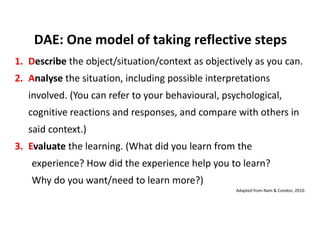Class 2 Handout.pdf
•
0 likes•1 view
This document outlines a three-step model for reflective learning: 1. Objectively describe the situation or context. 2. Analyze possible interpretations and explanations of the situation, including cognitive and behavioral reactions compared to others. 3. Evaluate what was learned from the experience, how it helped learning, and areas where more learning is needed.
Report
Share
Report
Share
Download to read offline

Recommended
Recommended
More Related Content
Similar to Class 2 Handout.pdf
Similar to Class 2 Handout.pdf (20)
Presentation1 2023 COT.pptx philosophy human person wwwwoh.

Presentation1 2023 COT.pptx philosophy human person wwwwoh.
In this week’s lecture, we focused on the discipline of primatolog.docx

In this week’s lecture, we focused on the discipline of primatolog.docx
Reflection PaperThe programs at the University of North America .docx

Reflection PaperThe programs at the University of North America .docx
TEACHERS of TOMORROW LESSON PLAN PROJECT FORMAT NAME .docx

TEACHERS of TOMORROW LESSON PLAN PROJECT FORMAT NAME .docx
PRACTICE #1 Practice Awareness SkillsInstructions for Practici.docx

PRACTICE #1 Practice Awareness SkillsInstructions for Practici.docx
Assessment for learning Lars Helle - Sviland Skole

Assessment for learning Lars Helle - Sviland Skole
Recently uploaded
Recently uploaded (6)
HONOURABLE LAWRENCE BANDASOA TABASE funeral brochure

HONOURABLE LAWRENCE BANDASOA TABASE funeral brochure
HONOURABLE LAWRENCE BANDASOA TABASE funeral brochure

HONOURABLE LAWRENCE BANDASOA TABASE funeral brochure
Class 2 Handout.pdf
- 1. 1. Describe the object/situation/context as objectively as you can. 2. Analyse the situation, including possible interpretations involved. (You can refer to your behavioural, psychological, cognitive reactions and responses, and compare with others in said context.) 3. Evaluate the learning. (What did you learn from the experience? How did the experience help you to learn? Why do you want/need to learn more?) DAE: One model of taking reflective steps Adapted from Nam & Condon, 2010.
- 2. escribe the object, situation, or context. Adapted from Nam & Condon, 2010.
- 3. 1
- 4. 2
- 5. 3
- 6. nalyse possible interpretations and explanations about it. Adapted from Nam & Condon, 2010.
- 7. 1
- 8. 2
- 9. 3
- 10. valuate the learning. Adapted from Nam & Condon, 2010.
- 11. l Share any episode/experience that you related to the stumbling blocks highlighted in Barna’s (2017) chapter. What does the experience mean to you? (How did it trigger particular awareness of yourself and/or others? What kind of new perspectives and understanding, alternative interpretations and/or behavioural choices have your learned/internalised from that?) Group Sharing
- 12. Tell your growth and adaptation process with STARS! • S (Situation)︓Describe the event or situation that involved any confusion/challenge. • T (Task)︓Explain the issue/task pertaining to the event or situation • A (Action)︓Explain the specific action you took to resolve/complete it. • R (Result)︓Explain the result of your action and efforts. • S (Skill)︓Highlight your skill and take-away from the experience.